D Link DIR320A1 802.11g Wireless Cable/DSL Internet Gateway w/USB User Manual Users manual3
D Link Corporation 802.11g Wireless Cable/DSL Internet Gateway w/USB Users manual3
D Link >
Contents
- 1. Users manual1
- 2. Users manual2
- 3. Users manual3
- 4. Users manual4
Users manual3
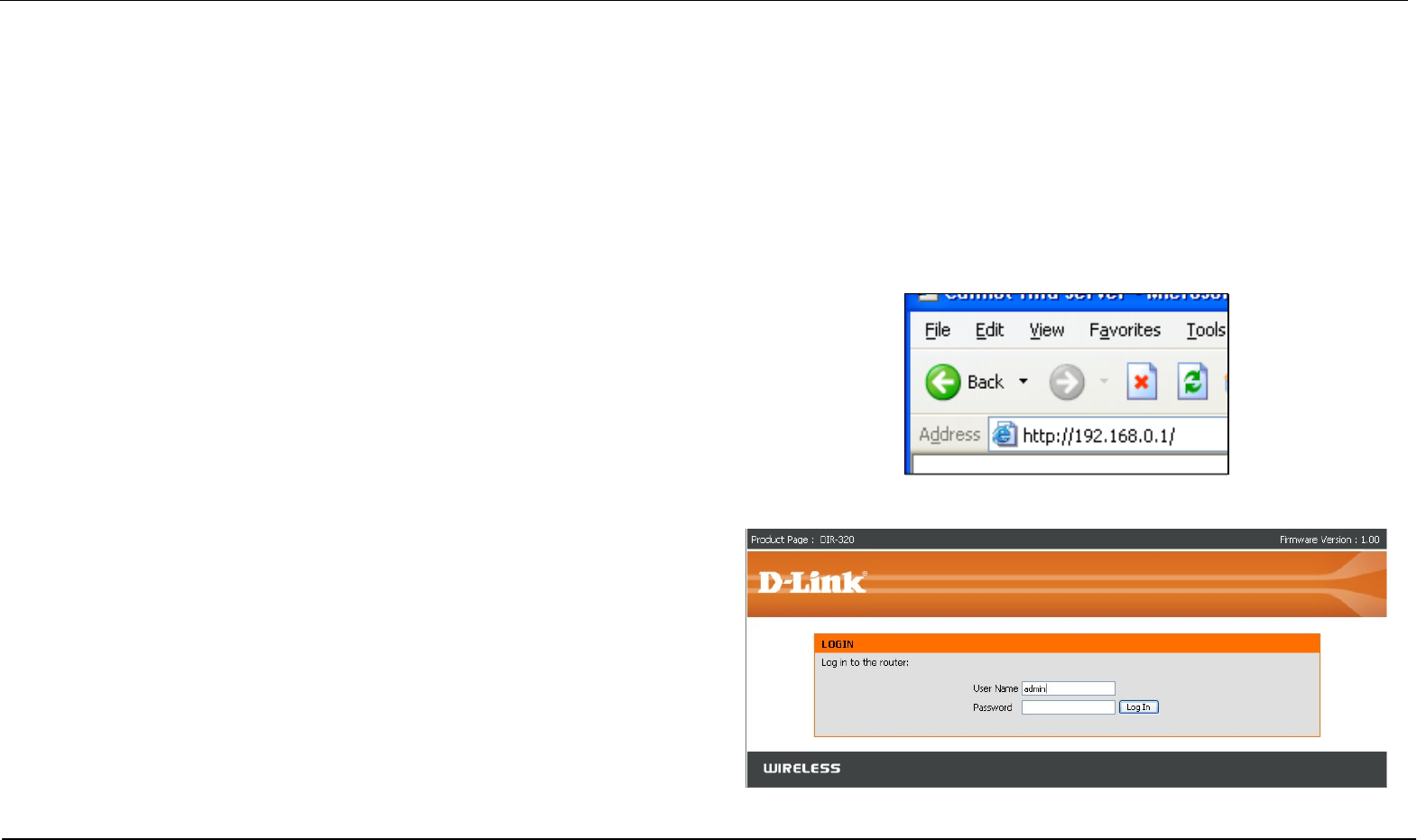
Section 3 – Configuration
D-Link DIR-320 User Manual 9
Configuration
This section will show you how to set up and configure your new D-Link router using the Web-based configuration utility.
Web-based Configuration Utility
Connect to the Router
To configure the WAN connection used by the router it is first necessary to communicate with the router through its management interface, which is
HTML-based and can be accessed using a web browser. The easiest way to make sure your computer has the correct IP settings is to configure it
to use the DHCP server in the router. The next section describes how to change the IP configuration for a computer running a Windows operating
system to be a DHCP client.
To access the configuration utility, open a web-browser such as Internet
Explorer and enter the IP address of the router (192.168.0.1).
Type “admin” for the User Name in the entry field. If this is the first time
configuring the router, leave the Password field blank, there is no default
password.
If you get a Page Cannot be Displayed error, please refer to the
Troubleshooting section for assistance.
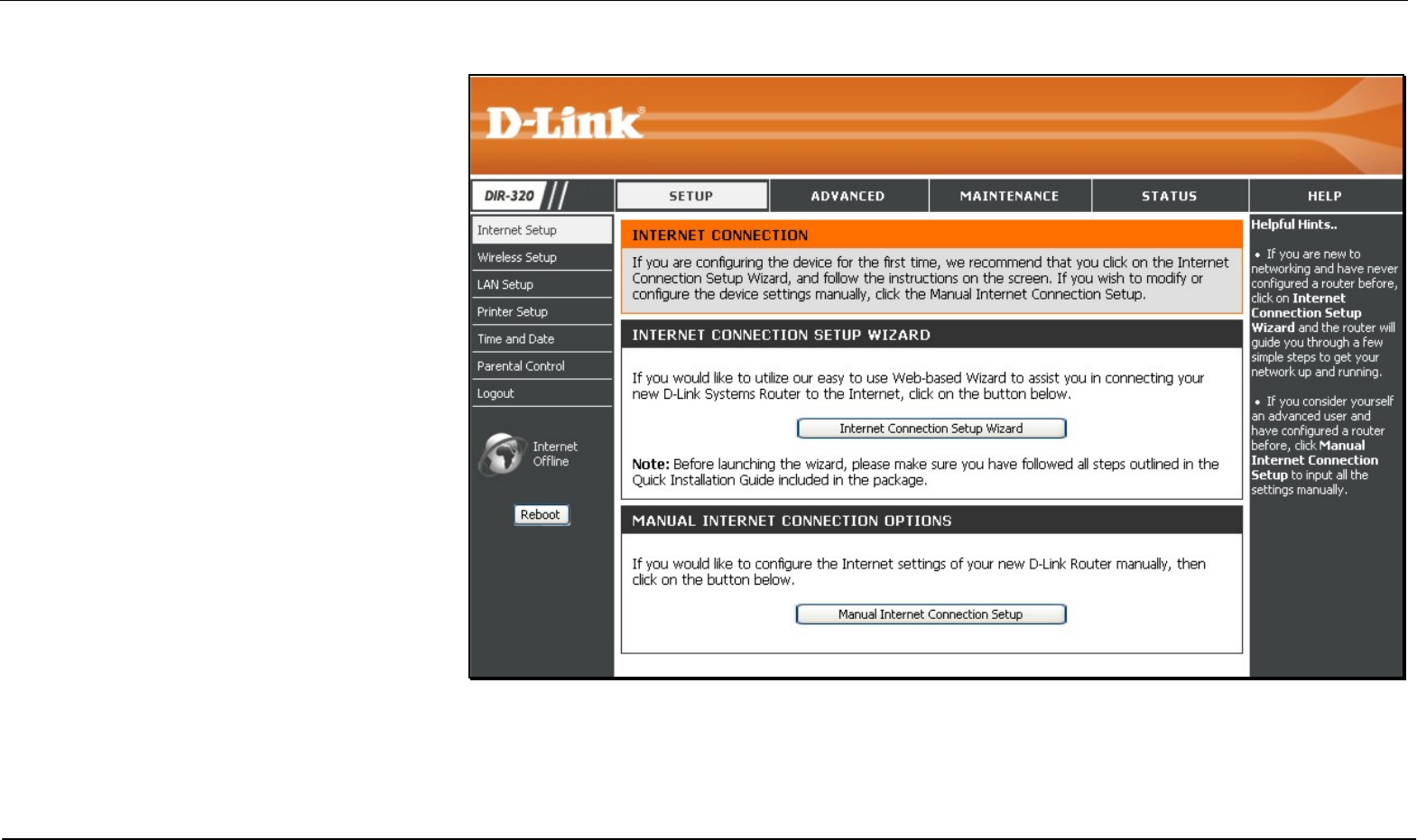
Section 3 – Configuration
D-Link DIR-320 User Manual 10
Configure Internet Connection - Setup Wizard
When you successfully connect to the web
manager, the main Internet Connection
menu displays two options for configuring the
Internet connection.
Click on he Internet Connection Setup
Wizard to quickly configure the Internet
connection. The Setup Wizard procedure is
described in the pages following this one.
To configure the connection in more detail,
click on the Manual Internet Connection Setup
button. Manual Internet connection setup is
described in Internet Connection - Configure
Internet Connection – Manual Setup on page
18 below.
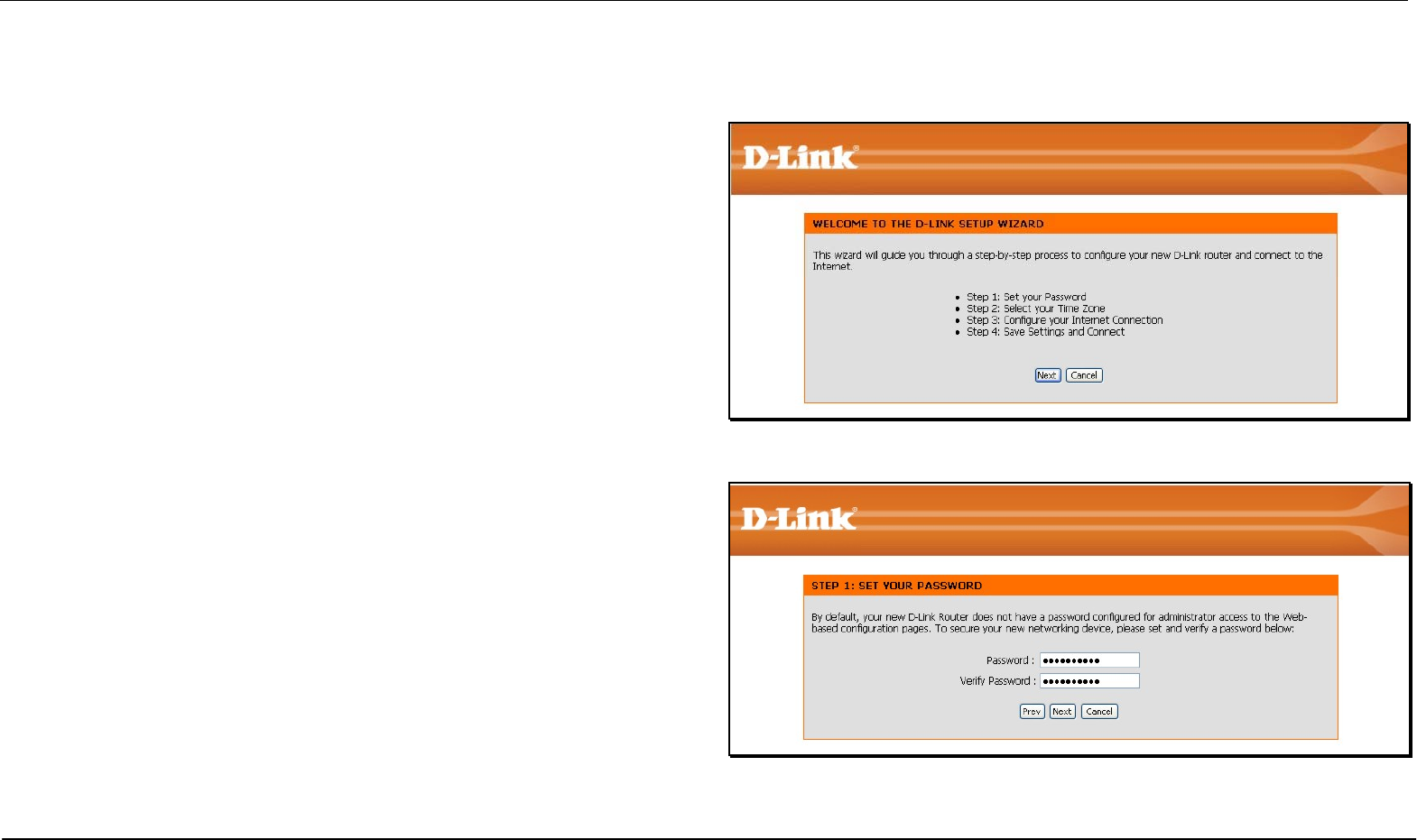
Section 3 – Configuration
D-Link DIR-320 User Manual 11
Internet Connection Setup Wizard
Use the Internet Connection Setup Wizard to quickly configure the Internet connection.
Setup Wizard
Click the Internet Connection Setup Wizard button and follow the
instructions in the menus that appear.
The initial window summarizes the setup process. These steps are as
follows:
1. Set the new password.
2. Select the time zone.
3. Configure the connection to the Internet.
4. Save settings and reboot the router.
Click the Next button to proceed. You may stop using the Setup Wizard at
any time by clicking the Cancel button. I
Change the administrator account password, enter a new password in the
first Password entry field, re-type it exactly as before in the Verify
Password field, and click Next. If you wish to return to the previous
window during the setup process, click the Prev button.

Section 3 – Configuration
D-Link DIR-320 User Manual 12
Choose the time zone you are in from the pull-down menu and click Next.
This sets the system time used for the router. If you wish to return to the
previous window during the setup process, click the Prev button.
Select the Internet Connection Type used for the Internet connection. Your
ISP has given this information to you. The connection types available are
DHCP (Dynamic IP Address), Username/Password (PPPoE),
Username/Password (PPTP), Username/Password (L2TP),
Username/Password (Bigpond), Static IP Address Connection,
Russia PPTP (Dual Access) and Russia PPPoE (Dual Access). Each
connection type has different settings that are configured in the next menu
Select the Connection Type specific to your service and click Next.
Follow the instructions below for the type of connection you have
selected.

Section 3 – Configuration
D-Link DIR-320 User Manual 13
DHCP (Dynamic IP Address) - For Dynamic IP Address connections,
you may want to copy the MAC address of your Ethernet adapter to the
router. Some ISPs use the unique MAC address of your computer’s
Ethernet adapter for identification and for IP address assignment (DHCP)
when you first access their network. This can prevent the router (which
has a different MAC address) from being allowed access to the ISP’s
network (and the Internet). To clone the MAC address of your computer’s
Ethernet adapter, click the Clone MAC Address button. Click Next to
continue.
Username/Password (PPPoE) - For PPPoE connections, select the
Address Mode Dynamic IP or Static IP, type in the Username and
Password used to identify and verify your account to the ISP. Retype the
password again and if necessary, type a Service Name or domain name.
For Static IP address mode, type the IP Address assigned to your
account. Your ISP should provide this IP address along with other account
information. Click Next to continue.
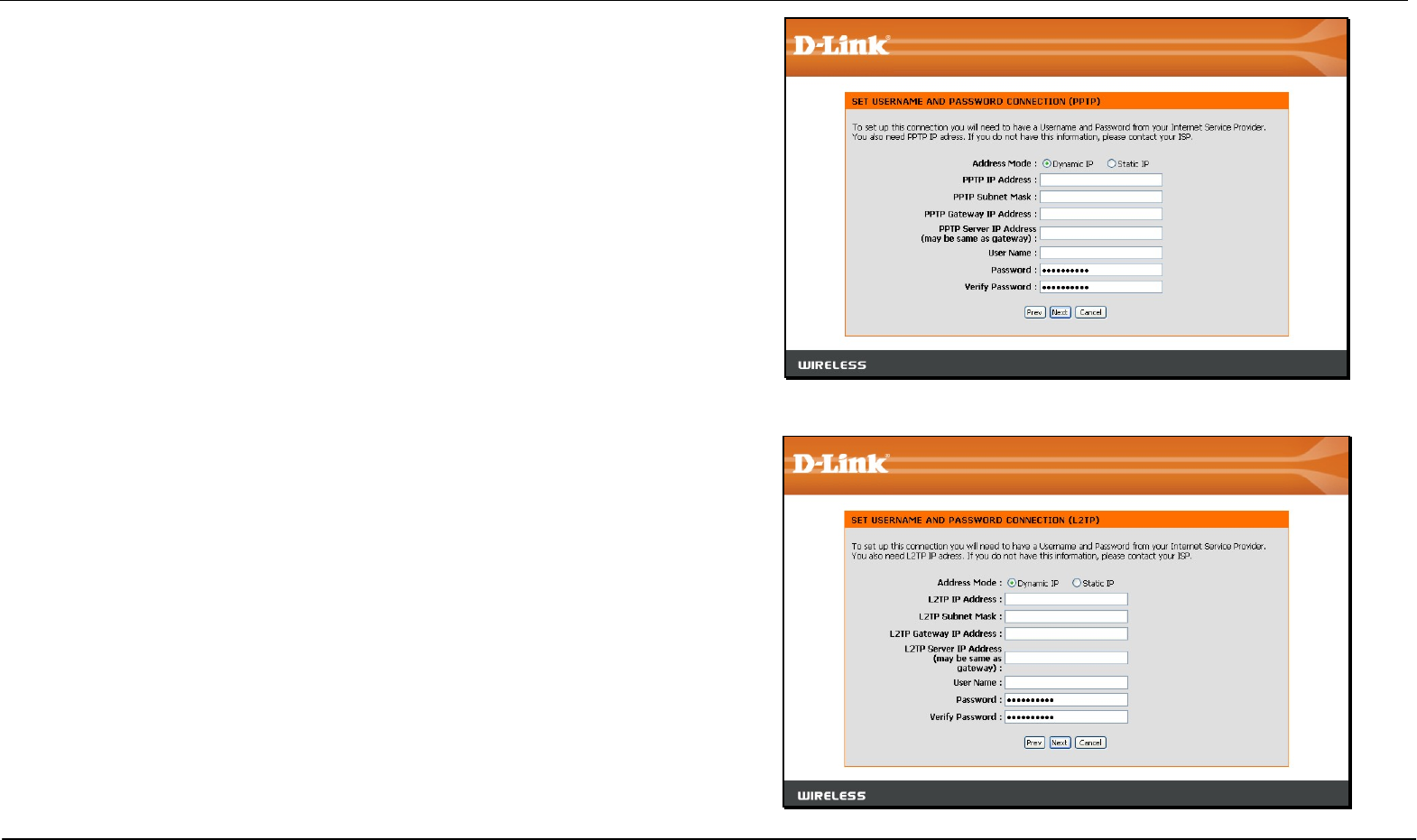
Section 3 – Configuration
D-Link DIR-320 User Manual 14
Username/Password (PPTP) - To configure the PPTP client connection,
enter the IP and account information for the router. Your ISP will give this
information to you if you are establishing a PPTP connection to the ISP.
Click Next to continue.
NOTE: The broadband device used for your Cable or ADSL network connection must support PPTP
pass-through so the VPN session can be established.
Username/Password (L2TP) - To configure the L2TP client connection,
enter the IP and account information for the router. Your ISP will give this
information to you if you are establishing a L2TP connection to the ISP.
Click Next to continue.
NOTE: The broadband device used for your Cable or ADSL network connection must support L2TP
pass-through so the VPN session can be established.

Section 3 – Configuration
D-Link DIR-320 User Manual 15
Username/Password (Bigpond) - BigPond Cable connections use this
Enter the account and server information, as provided to you by BigPond.
Click Next to continue.
Static IP Address Connection - For Static IP Address connection types,
you must type in the IP Address, Subnet Mask, Gateway Address,
Primary DNS Address and Secondary DNS Address (optional). Your
ISP should provide this information to you. Click Next to continue.

Section 3 – Configuration
D-Link DIR-320 User Manual 16
Russia PPTP (Dual Access) - To configure the PPTP client connection,
enter the IP and account information for the router. Your ISP will give this
information to you if you are establishing a PPTP connection to the ISP.
Click Next to continue.
NOTE: The broadband device used for your Cable or ADSL network connection must support PPTP
pass-through so the VPN session can be established.
Russia PPPoE (Dual Access) - For PPPoE connections, select the
Address Mode Dynamic IP or Static IP, type in the Username and
Password used to identify and verify your account to the ISP. Retype the
password again and if necessary, type a Service Name or domain name.
For Static IP address mode, type the IP Address assigned to your
account. Your ISP should provide this IP address along with other account
information. An additional set of IP settings might be required to create a
static route to the ISP. Enter the WAN IP settings used to create this route
(as given by the ISP) and click Next to continue.

Section 3 – Configuration
D-Link DIR-320 User Manual 17
When you are satisfied that the settings have been entered correctly click
on the Connect button to save the new configuration settings.
During the save and restart procedure, the display informs that it is
rebooting. Once the reboot is complete, begin to use the router.
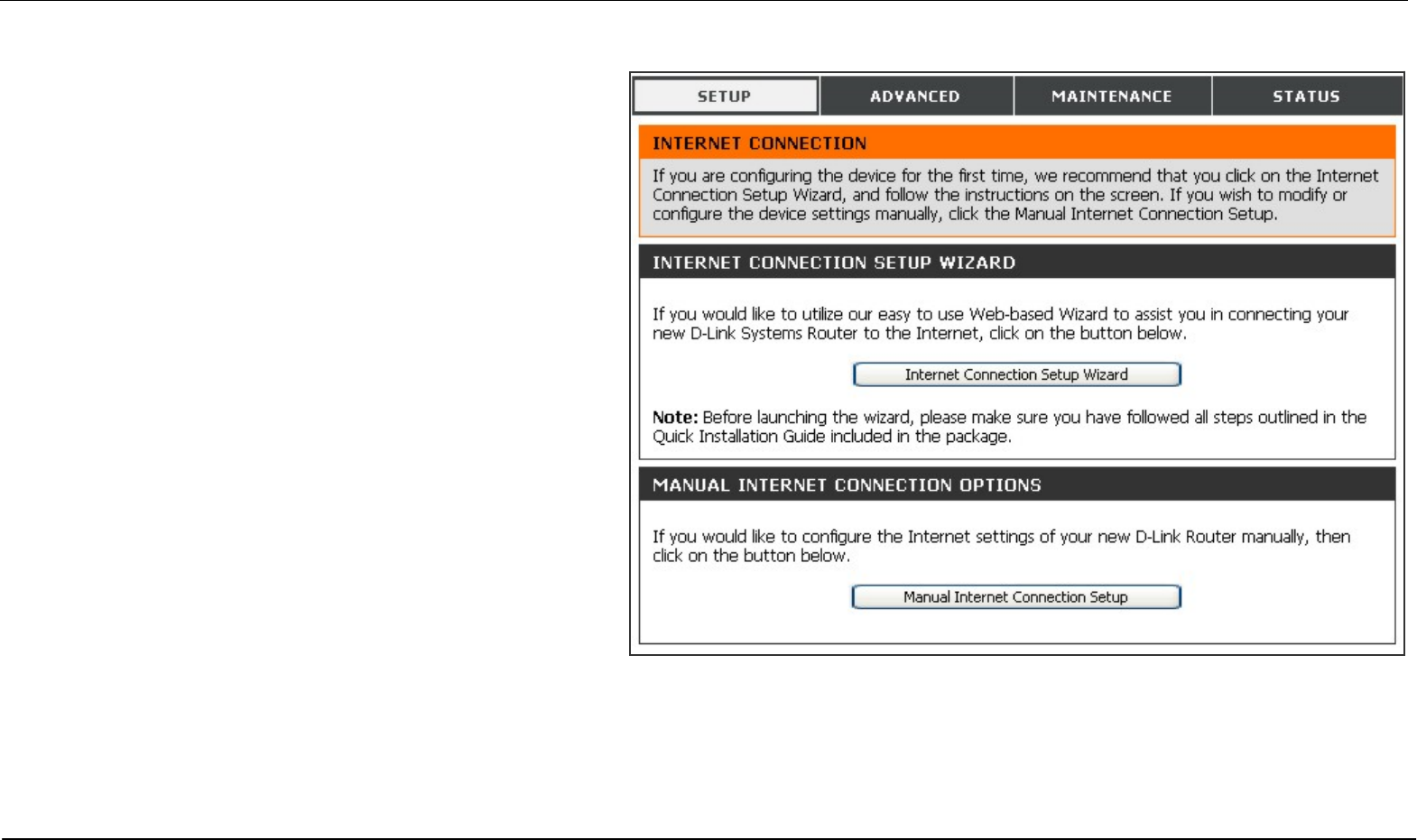
Section 3 – Configuration
D-Link DIR-320 User Manual 18
Configure Internet Connection – Manual Setup
The Internet connection can be configured manually without
using the Setup Wizard. To configure Internet connection
settings manually click on the Manual Internet Connection
Setup button in the Internet Connection menu.
In the new menu select the Internet Connection type used for
your service from the My Internet Connection is: pull-down
menu. Follow the instructions in the next sections according to
the type of Internet connection you want to configure.
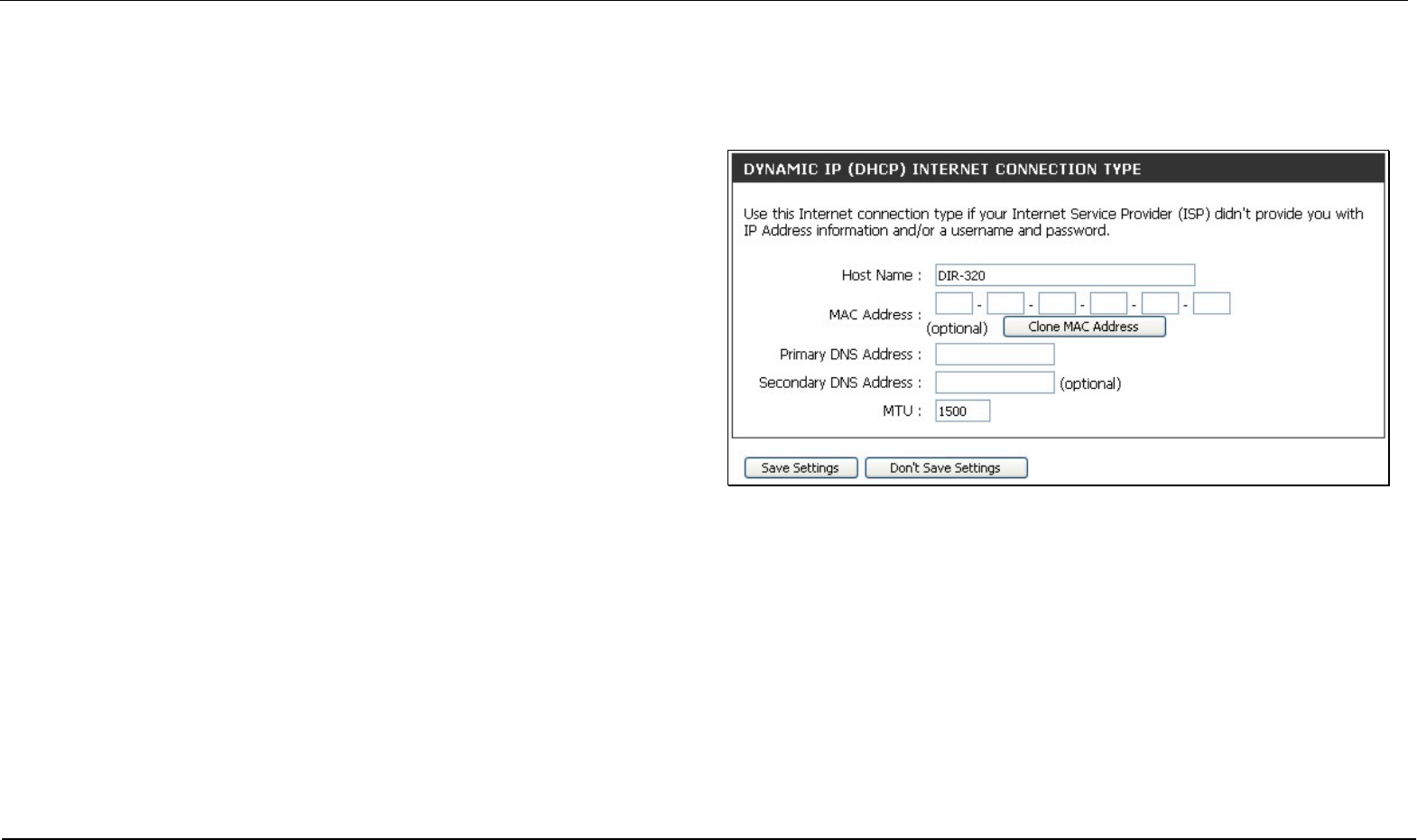
Section 3 – Configuration
D-Link DIR-320 User Manual 19
Dynamic IP Address
To configure a Dynamic IP Address Internet connection, follow these
steps:
1. Select the Dynamic IP (DHCP) option from the My Internet
Connection is: pull-down menu.
2. Under the Dynamic IP heading, type a Host Name if needed, and
DNS IP address information. The Primary DNS Address will be
normally be required, the Secondary DNS Address is used for a
back up DNS server.
3. Some ISPs record the unique MAC address of your computer’s
Ethernet adapter when you first access their network. This can
prevent the Router (which has a different MAC address) from being
allowed access to the ISPs network (and the Internet). To clone the
MAC address of your computer’s Ethernet adapter, type in the
MAC address in the MAC Address field and click the Clone MAC
Address button.
4. Leave the MTU value at the default setting (default = 1500) unless
you have specific reasons to change this (see table below for more
information).
5. Click on the Save Settings button to save and apply the new
Internet connection settings.
A Dynamic IP Address connection configures the Router to
automatically obtain its global IP address from a DHCP server on the
ISP’s network.
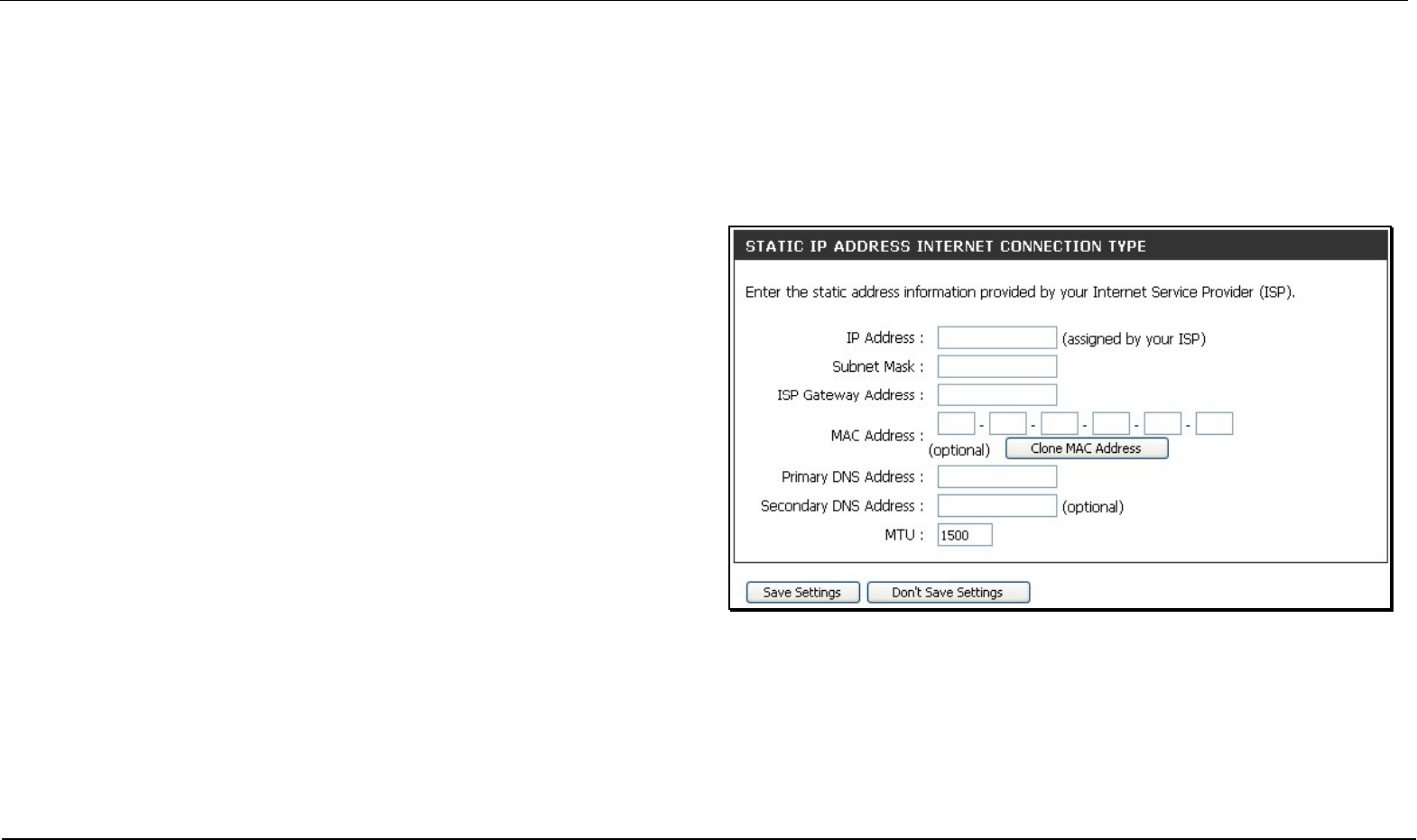
Section 3 – Configuration
D-Link DIR-320 User Manual 20
Static IP Address
To configure a Static IP type Internet connection, follow these steps:
1. Select the Static IP option from the My Internet Connection is:
pull-down menu.
2. Under the Static IP heading, type IP address information provided
by your ISP, type an IP Address, Subnet Mask and ISP Gateway
Address. The Primary DNS Address will be normally be required,
the Secondary DNS Address is used for a back up DNS server.
3. Some ISPs record the unique MAC address of your computer’s
Ethernet adapter when you first access their network. This can
prevent the Router (which has a different MAC address) from being
allowed access to the ISPs network (and the Internet). To clone the
MAC address of your computer’s Ethernet adapter, type in the
MAC address in the MAC Address field and click the Clone MAC
Address button.
4. Leave the MTU value at the default setting (default = 1500) unless
you have specific reasons to change this (see table below for more
information).
5. Click on the Save Settings button to save and apply the new
Internet connection settings.
When the Router is configured to use Static IP Address assignment
for the Internet connection, you must manually assign a global IP
Address, Subnet Mask, and ISP Default Gateway IP address. Most
users will also need to configure DNS server IP settings. Follow the
instruction below to configure the Router to use Static IP Address
assignment for the Internet connection.
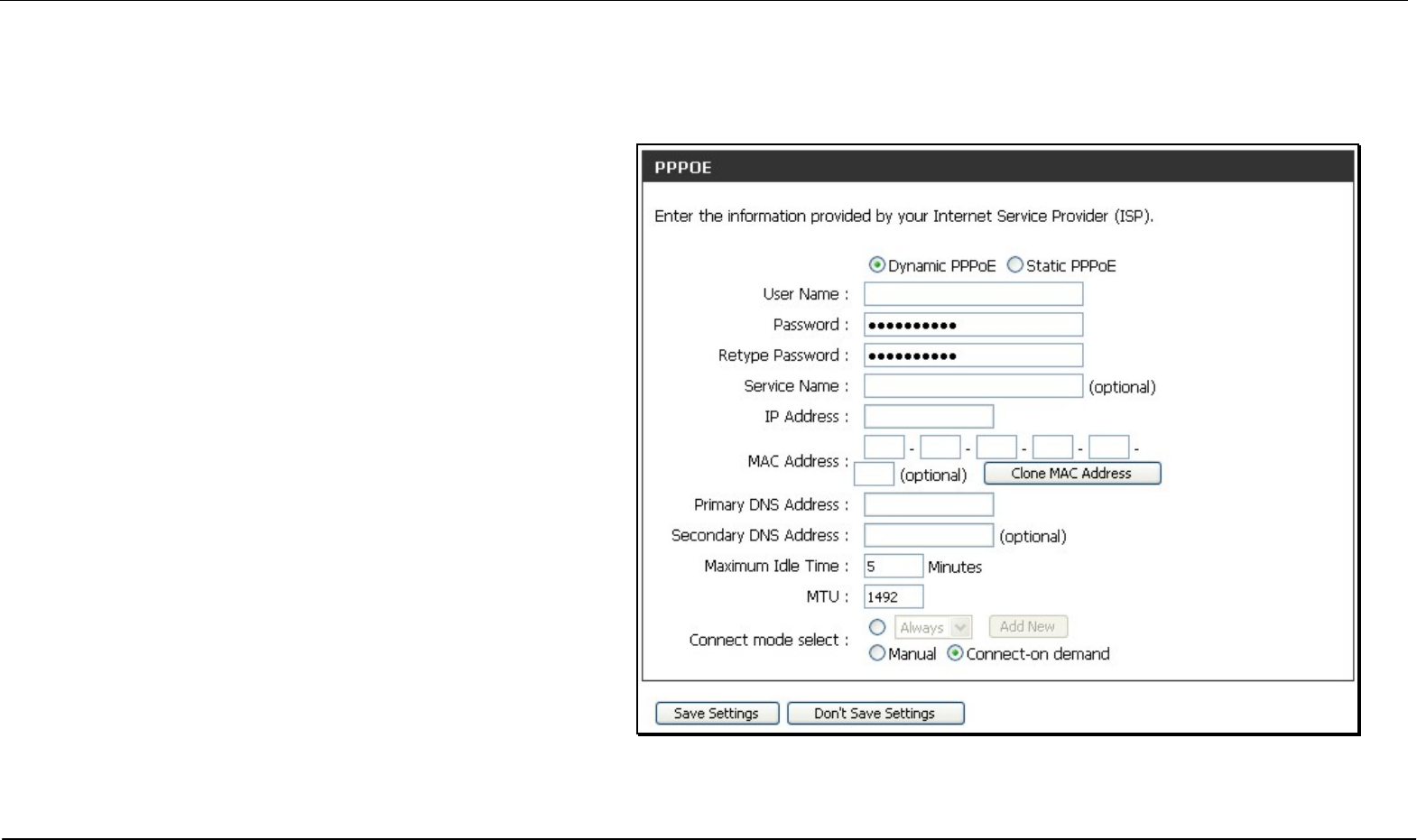
Section 3 – Configuration
D-Link DIR-320 User Manual 21
PPPoE
PPP or Point-to-Point protocol is a standard method of establishing a network connection/session between networked devices. Different forms of
PPP include PPPoA and PPPoE (discussed below) involve an authentication process that requires a username and password to gain access to the
network. PPPoE (PPP over Ethernet), as described in RFC 2516, is a method of using PPP through the Ethernet network.
To configure a PPPoE Internet connection, follow these steps:
1. Select the PPPoE (Username / Password) option from
the My Internet Connection is: pull-down menu.
2. Choose the IP address assignment option (Dynamic
PpoE or Static PPPoE). Static IP address assignement
requires manual entry of IP settings information.
3. Under the PPPoE heading, type the User Name and
Password used for your account. A typical User Name
will be in the form user1234@isp.co.ru. The Password may
be assigned to you by your ISP or you may have selected
it when you set up the account with your ISP. Type the
password again in Confirm Password.
4. For Static PPPoE connections, enter IP settings provided
by the ISP and, if necessary enter MAC address (see
table below)
5. Leave the MTU value at the default setting (default =
1492) unless you have specific reasons to change this
(see table below for more information).
6. Choose the desired Connection Setting. Select from:
Always ON, Connection On Demand, or Manual. Most
users will want to choose the default connection setting,
Always ON.
See table below for parameter description.

Section 3 – Configuration
D-Link DIR-320 User Manual 22
Some of the settings do not need to be changed the first time the device is set up, but can be changed later if you choose. The information that is to
be provided in this window must be given to you by your ISP and must be carefully configured. Any small discrepancy will send the wrong message
to your ISP’s server and inhibit your connection.
There are two ways to configure the PPoE connection on the router, one is for a Dynamic PPPoE configuration, which means the router will
implement some settings automatically through DHCP, such as the router’s IP address and the default gateway. The other is through a Static
PPPoE connection, in which the user must configure the IP address and the DNS addresses automatically.
PPPoE Description
User Name The user name supplied to you by your ISP.
Password The password supplied to you by your ISP.
Retype Password Retype the password entered in the Password feld.
Service Name Enter the service name supplied to you by your ISP, if required.
IP Address Enter the IP address given to you by your ISP. This field is only to be completed if the Static PPPoE button is selected.
MAC Address This field will instruct the user to enter the Media Access Control (MAC) address of the Ethernet Card of your computer, if instructed
to do so by your ISP. To quickly accomplish this, click the Clone MAC address button, which will automatically copy the MAC address
of your Ethernet card and enter it into the space provided, which will replace the MAC address of the router.
Primary DNS Address This entry is for the IP address of your primary domain name server, which should also be provided to you by your ISP. The router
will first try the Primary DNS Address to resolve a website’s URL IP address. If this IP address fails, the router will then try the
Secondary DNS Address. This field is only to be completed if the Static PPPoE button is selected.
Secondary DNS
Address The IP address of the secondary domain name server will be used to resolve a website’s URL IP address if the Primary DNS Address
fails. The information in this field should also be provided by your ISP and is only to be completed if the Static PPPoE button is
selected.
Maximum Idle Time A value of 0 means that the PPP connection will remain connected. If your network account is billed according to the amount of time
the Router is actually connected to the Internet, enter an appropriate Idle Time value (in seconds). This will disconnect the Router
after the WAN connection has been idle for the amount of time specified. The default value = 5.
MTU This field refers to the Maximum Transfer Unit, which is the maximum size of a packet, in bytes, that will be accepted by the router.
The default setting is 1492 bytes. This field should not be altered unless instructed by your ISP.
Connect Mode Select This function, with Connect-on-demand selected, will allow the router to connect any workstation on your LAN to the Internet upon
request. If this function is set at Always-on, no request from the workstation will be needed to connect to the Internet. If Manual
is selected, it will be necessary for the workstation on the LAN to manually connect to the Internet through this router.
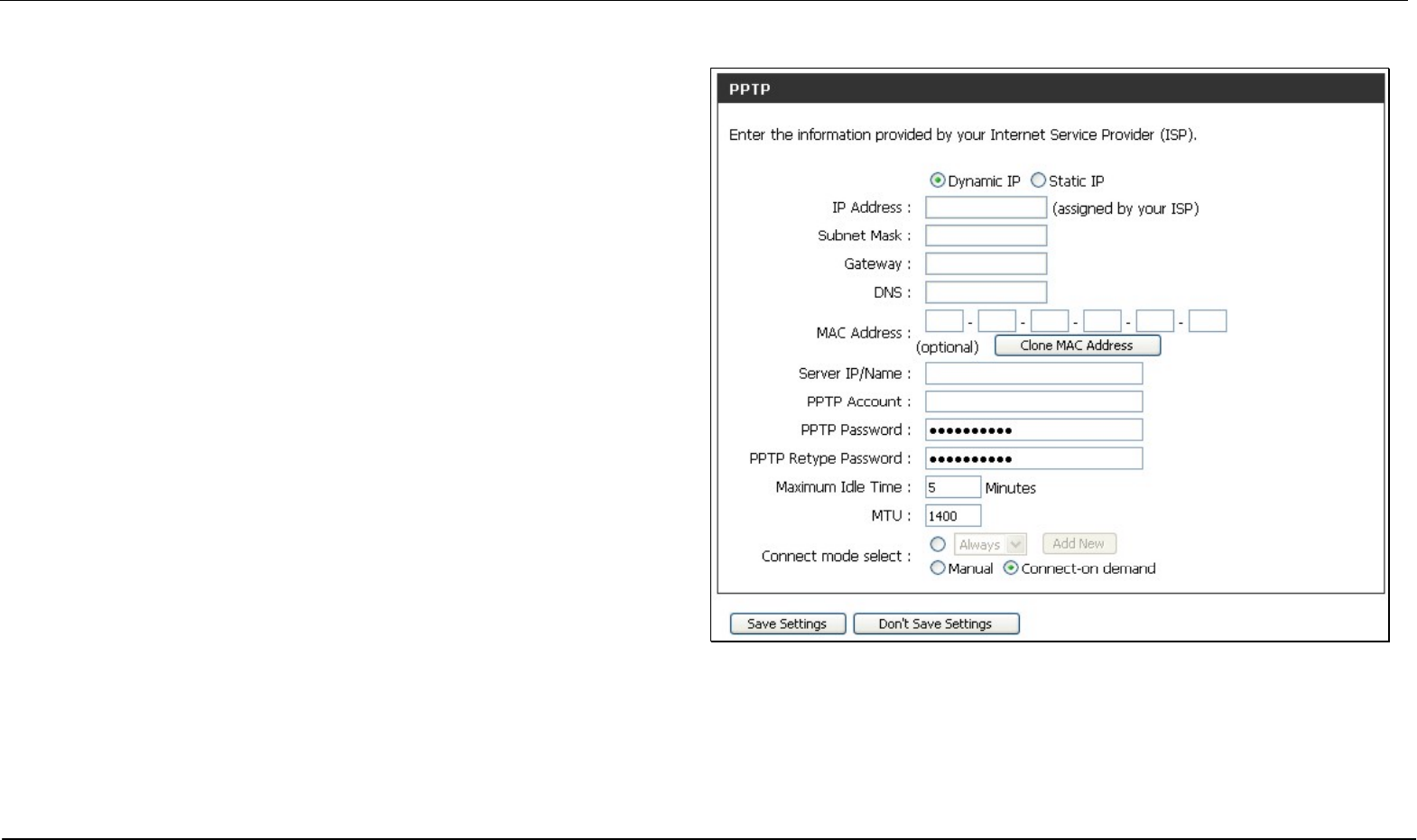
Section 3 – Configuration
D-Link DIR-320 User Manual 23
PPTP
The Point to Point Tunneling Protocol is used to transfer information
securely between VPNs (Virtual Private Routers). Encryption methods
are employed in the transfer of information between you and your ISP
using a key encryption. This option is specific for European users where
ISPs support the PPTP protocol for the uplink connection. To connect to
your ISP’s server using this protocol, the information in this window
must be provided to you by your ISP and then properly implemented.
There are two ways to enable the router to become a PPTP client, one
is through assigning the router an IP address dynamically, which means
that the DHCP protocol will be implemented by the Router to
automatically configure the IP settings. The user may input the IP
settings manually by choosing the Static IP option above the configuring
area. To configure the router to be a PPTP client, complete the entry
fields and click the Save Settings button.
See table below for parameter description.

Section 3 – Configuration
D-Link DIR-320 User Manual 24
PPTP/L2TP Description
IP Address Enter the IP address of the router into this field. This address must be supplied to you by your ISP. This field will not be necessary
to configure if the Dynamic IP option is chosen above the configuring field.
Subnet Mask Enter the IP address of the Subnet Mask into this field. This address must be supplied to you by your ISP. This field will not be
necessary to configure if the Dynamic IP option is chosen above the configuring field.
Gateway Enter the IP address of the gateway into this field. This address must be supplied to you by your ISP. This field will not be
necessary to configure if the Dynamic IP option is chosen above the configuring field.
DNS Enter the IP address of the DNS. This field will not be necessary to configure if the Dynamic IP option is chosen above the
configuring field.
MAC Address This field will instruct the user to enter the Media Access Control (MAC) address of the Ethernet Card of your computer, if
instructed to do so by your ISP. To quickly accomplish this, click the Clone MAC address button, which will automatically copy
the MAC address of your Ethernet card and enter it into the space provided, which will replace the MAC address of the router.
Server IP/Name Enter the Server IP address for this protocol into this field. This is the IP address of the server computer that will be used, along
with your computer, to create the Virtual Private Network. This field must be completed for both the Dynamic IP and Static IP
options
PPTP/L2TP Account Enter the PPTP/L2TP account name, provided to you by your ISP, here.
PPTP/L2TP Password Enter your password for this PPTP/L2TP account here, as stated to you by your ISP.
PPTP/L2TP Retype
Password Retype the password entered in the PPTP/L2TP Password field.
Maximum Idle Time A value of 0 in this field means that the PPTP/L2TP connection will remain connected. If your network account is billed according
to the amount of time the Router is actually connected to the Internet, enter an appropriate Idle Time value (in seconds). This
will disconnect the Router after the WAN connection has been idle for the amount of time specified. The default value = 5.
MTU This field refers to the Maximum Transfer Unit, which is the maximum size of a packet, in bytes, that will be accepted by the
router. The default setting is 1460 bytes. This field should not be altered unless instructed by your ISP.
Connect Mode Select This function, with Connect-on-demand selected, will allow the router to connect any workstation on your LAN to the Internet
upon request. If this function is set at Always-on, no request from the workstation will be needed to connect to the Internet. If
Manual is selected, it will be necessary for the workstation on the LAN to manually connect to the Internet through this router.
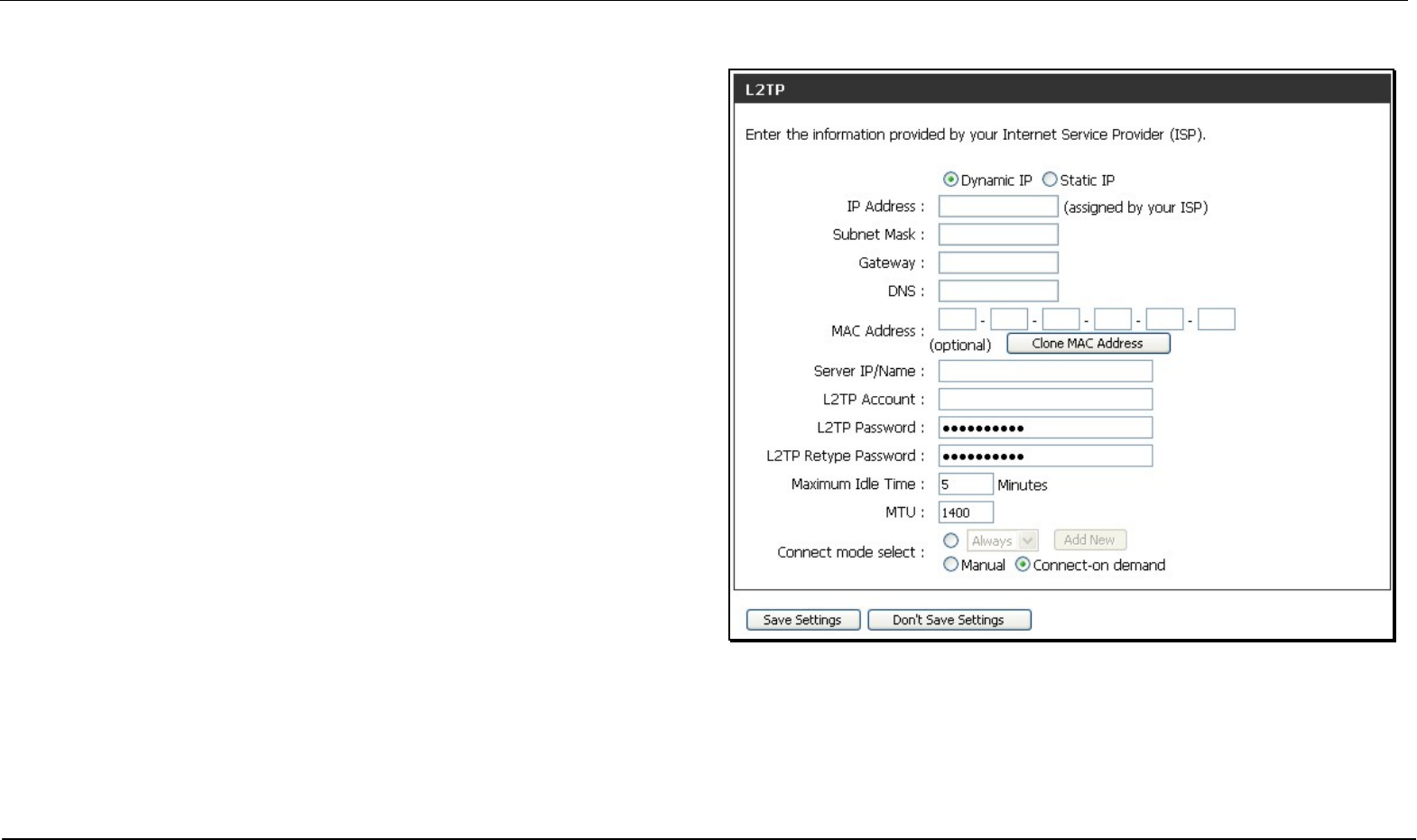
Section 3 – Configuration
D-Link DIR-320 User Manual 25
L2TP
L2PT, or Layer 2 Tunneling Protocol is a VPN protocol that will ensure a
direct connection to the server using an authentication process that
guarantees the data originated from the claimed sender and was not
damaged or altered in transit. Once connected to the VPN tunnel, it
seems to the user that the client computer is directly connected to the
internal network. To set up your L2PT connection, enter the data that was
provided to you by your ISP.
There are two ways to enable the router to become a L2TP client, one is
through assigning the router an IP address dynamically, which means that
the DHCP protocol will be implemented by the Router to automatically
configure the IP settings. The user may input the IP settings manually by
choosing the Static IP option above the configuring area. To configure the
router to be a L2TP client, complete the following fields and click the Save
Settings button.
See table on previous page for parameter description.
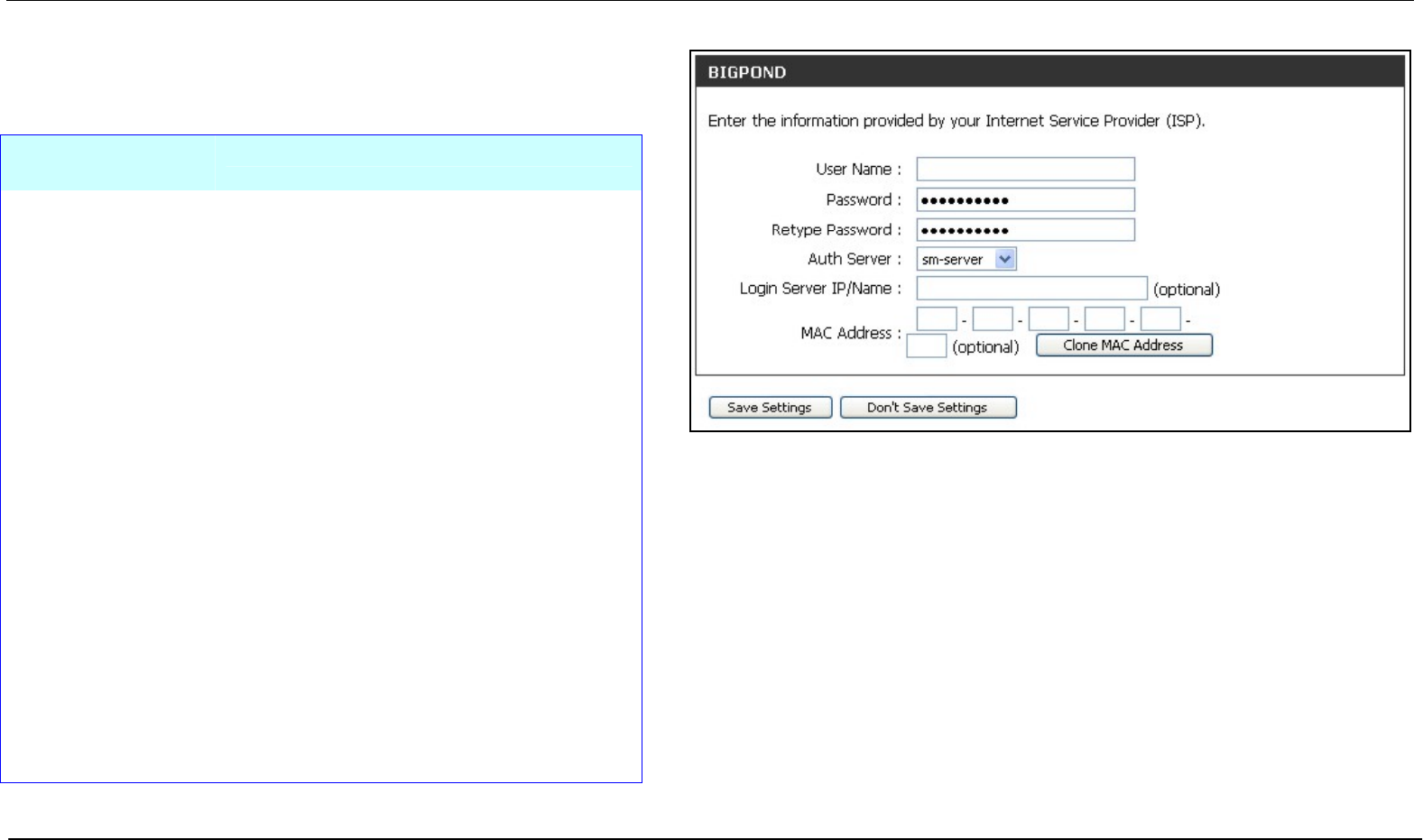
Section 3 – Configuration
D-Link DIR-320 User Manual 26
BigPond
BigPond Cable connections use this menu to configure account and
connection information. Enter the account information, as provided to
you by BigPond. Click Next to continue.
BigPond
Connection Setting Description
Auth Server Enter the name of the Authentication Server
as provided to you by BigPond.
User Name The account name of the account that has
been assigned to you by BigPond.
Password The password of the account that was
supplied to you by BigPond.
Confirm Password Retype the password that was entered in the
BigPond Password field. Ensure that these
two passwords are identical or an error will
occur.
Login Server
IP/Name Enter the Server IP address for this protocol
into this field. This is the IP address of the
server computer that will be used, along with
your computer, to create the Virtual Private
Network. This field must be completed for
both the Dynamic IP and Static IP options
MAC Address This field will instruct the user to enter the
Media Access Control (MAC) address of the
Ethernet Card of your computer, if instructed
to do so by your ISP. To quickly accomplish
this, click the Clone MAC address button,
which will automatically copy the MAC
address of your Ethernet card and enter it
into the space provided, which will replace
the MAC address of the router.
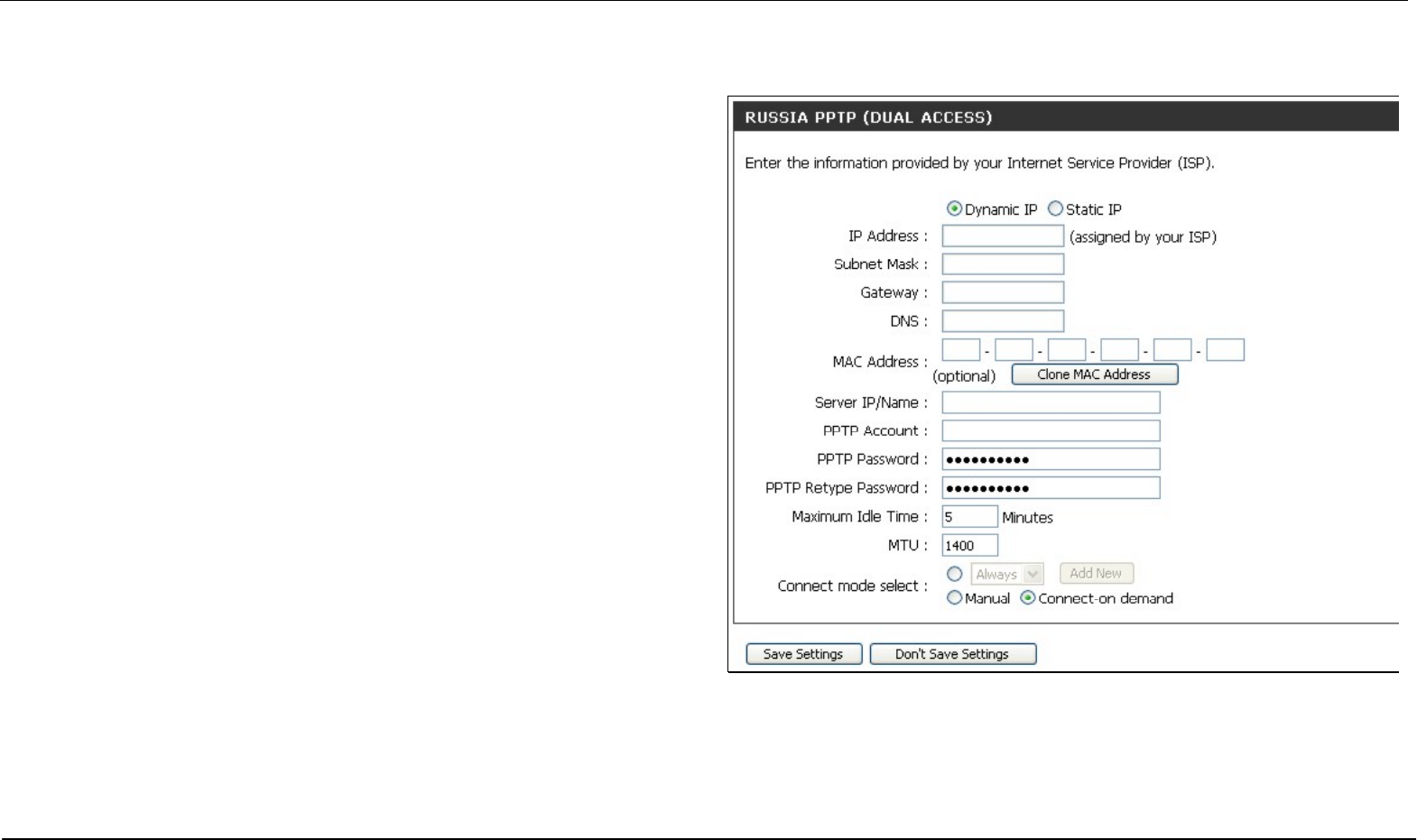
Section 3 – Configuration
D-Link DIR-320 User Manual 27
PPTP Russia
The PPTP Russia setup is identical to the previously described PPTP
setup on page 23 except an option to use a MAC address that will always
be associated with the connection. The MAC address is entered manually
or copied form the computer.
To configure a PPTP Russia Internet connection, configure as previously
described for PPTP connections and type in the MAC address that will be
used or clone the computer’s MAC address by clicking on the Clone MAC
Address button.

Section 3 – Configuration
D-Link DIR-320 User Manual 28
PPPoE Russia
Some PPPoE connections use a static IP route to the ISP in addition to
the global IP settings for the connection. This requires an added step to
define IP settings for the physical WAN port.
To configure a PPPoE Russia Internet connection, configure as previously
described for PPPoE connections on page 21 and add the WAN Physical
IP settings as instructed from the ISP.
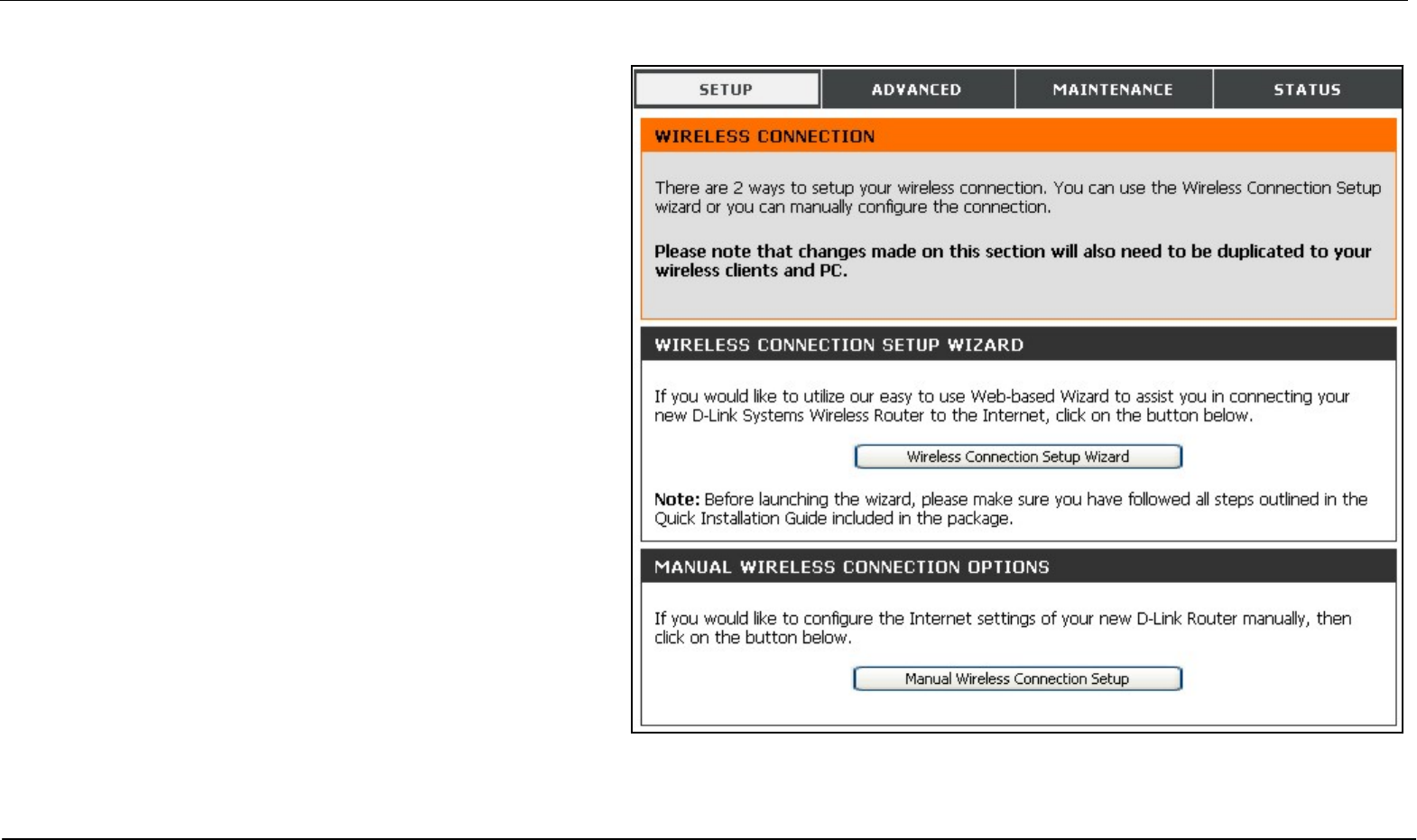
Section 3 – Configuration
D-Link DIR-320 User Manual 29
Configure Wireless Connection - Setup Wizard
Configure the router’s wireless access point with the Wireless
Connection Setup Wizard and follow the instructions that
follow. Or use the manual configuration option. To configure
basic wireless and wireless security settings manually click on
the Manual Wireless Connection Setup button.
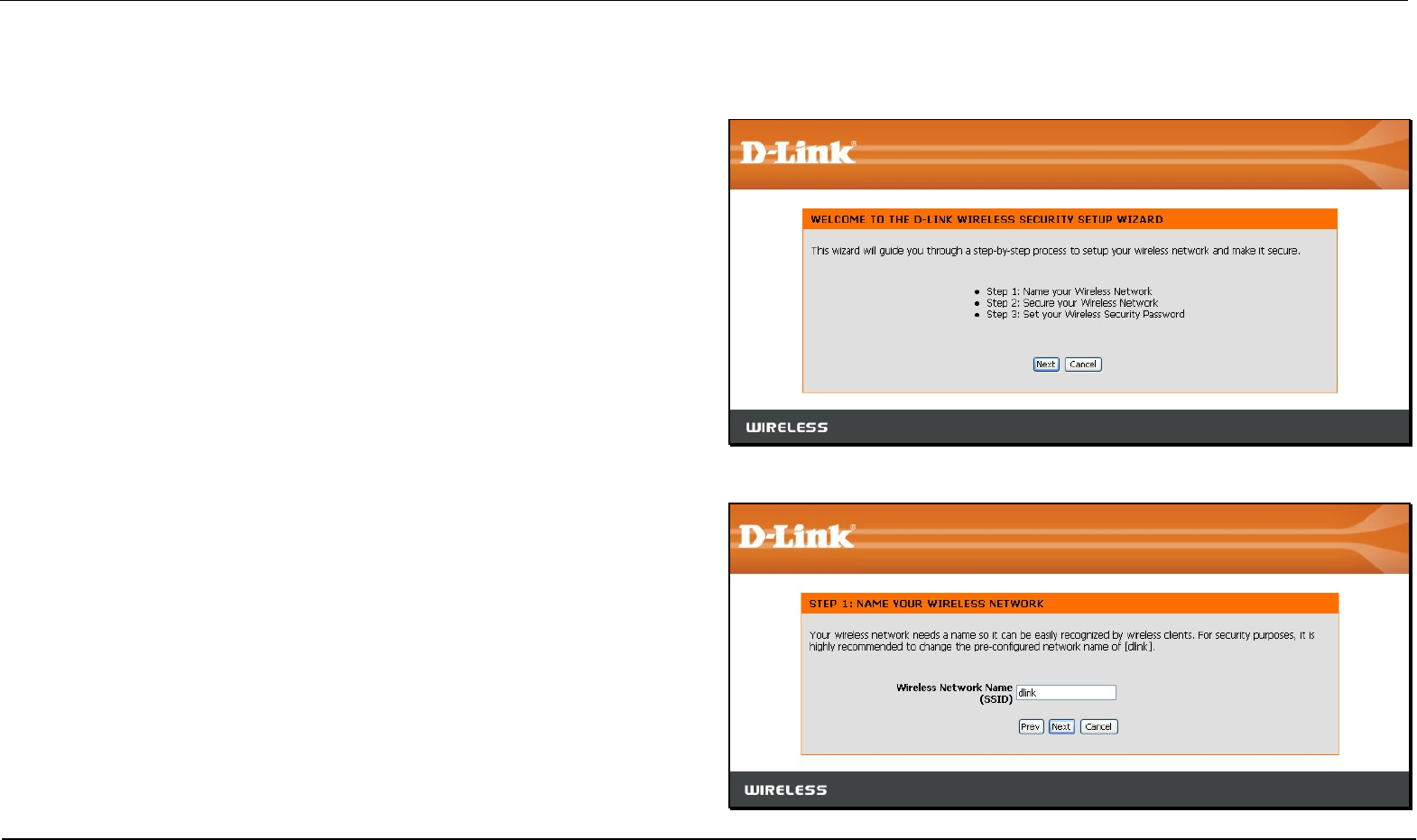
Section 3 – Configuration
D-Link DIR-320 User Manual 30
Wireless Connection Setup Wizard
Use the Wireless Connection Setup Wizard to quickly configure the Internet connection. Click on the Wireless Connection Setup Wizard button in
the Wireless Connection menu to begin using the wizard.
The first wizard menu provides a summary of the setup procedure. The
procedure is the same for all security types used. If you want to make
specific changes to wireless security settings, use the manual wireless
connection setup option. The steps for wireless connection setup are:
1. Name your wireless network
2. Secure your wireless network
3. Set your wireless security password
Click the Next button to proceed.
Type the SSID or name of your wireless network and click Next to
proceed. Any wireless client or device that associates with the router must
have this SSID.
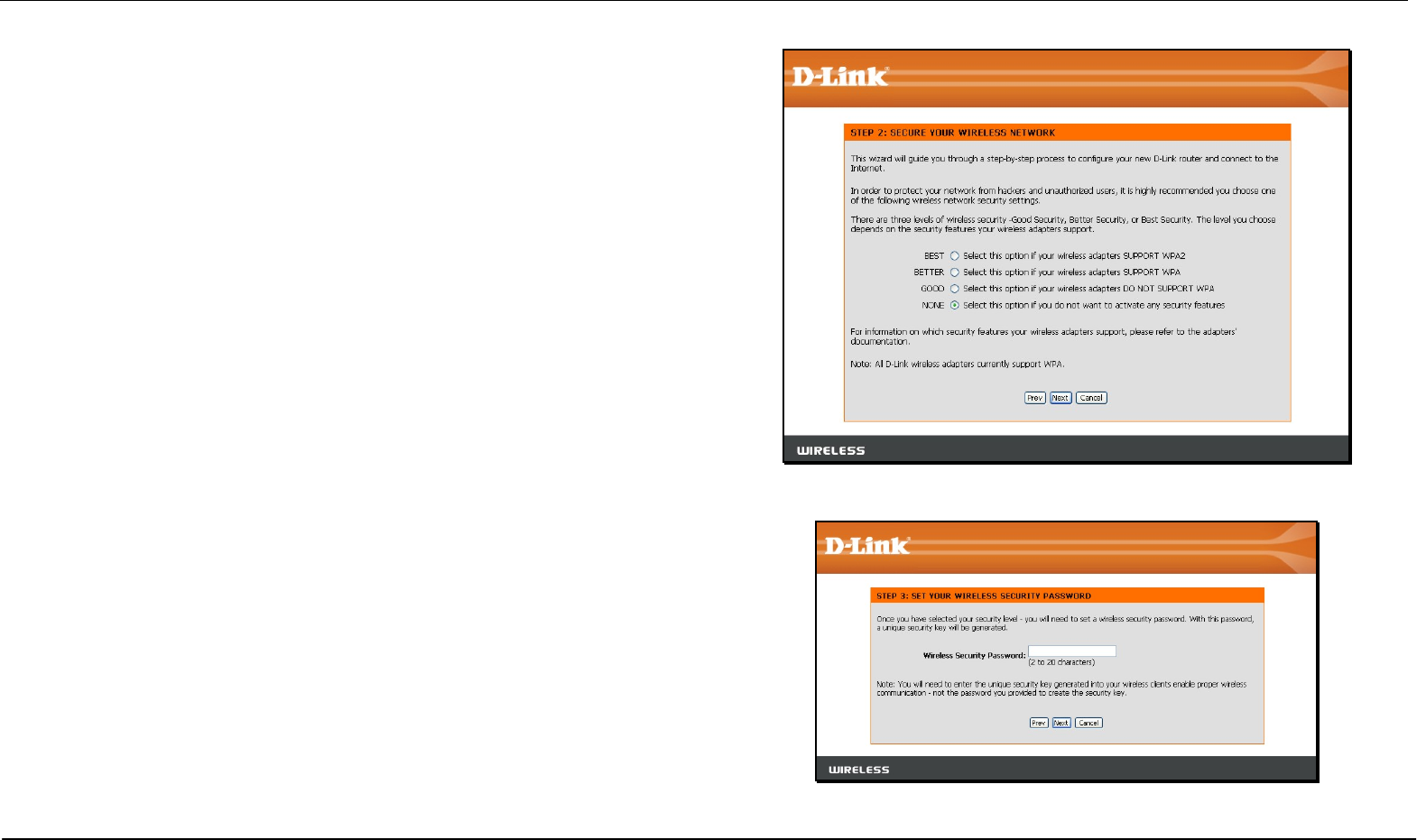
Section 3 – Configuration
D-Link DIR-320 User Manual 31
Select the level of security for the wireless network. The choice will
determine the method used for security. The security options are:
• Best – using WPA2
• Better – using WPA
• Good – using WEP
• None – no security for the wireless connection
Remember that all wireless clients that will associate with the router must
use the same security settings.
Click Next to continue to proceed.
Type the password used for security. The password will be converted into
the appropriate form used with the security option chosen before.
Click Next to continue to proceed.

Section 3 – Configuration
D-Link DIR-320 User Manual 32
Wireless setup is completed. Review the wireless settings SSID and
security information. It is a good idea to keep a record of the wireless
settings in order to configure clients that will associate with the router.
Click Next to continue to save the new wireless settings and restart the
router.
Restarting will take several seconds. Once the router has restarted the
wireless settings just configured will be applied.

Section 3 – Configuration
D-Link DIR-320 User Manual 33
Wireless Connection – Manual Setup
The wireless connection can be configured manually without using
the Setup Wizard. To configure wireless connection settings
manually click on the Manual Wireless Connection Setup button
in the Wireless Connection menu.
The two essential settings for wireless LAN operation are the
Wireless Network Name or SSID and Wireless Channel number.
The SSID (Service Set Identifier) is used to identify a group of
wireless LAN components. The SSID can be broadcast in order to
allow properly configured wireless stations to learn the SSID and
join the group.

Section 3 – Configuration
D-Link DIR-320 User Manual 34
Wireless Network Settings
Use the Enable Wireless check box to disable or enable the wireless
interface. Wireless function is enabled by default.
The Wireless Network Name or SSID can be changed to suit your
wireless network. Remember that any wireless device using the access
point must have the same SSID and use the same channel. The SSID can
be a continuous character string (i.e. no spaces) of up to 16 characters in
length.
Wireless stations that support WPS can be configured automatically using
the Wi-Fi Protected Setup menu.
To manually configure security settings, select the Wireless Security
Mode form the pull-down menu and configure the settings for the security
method used. Follow the instructions below for the type of security used.
Click the Save Settings button to save any changes to the wireless
network settings.

Section 3 – Configuration
D-Link DIR-320 User Manual 35
Wi-Fi Protected Setup
Wi-Fi Protected Setup or WPS makes wireless security configuration
much quicker simpler for wireless stations that support this feature.
NOTE: The Generate New PIN button is for the Router’s own PIN. This is used when the
Router needs to connect to other WPS enabled access points.
To connect a new wireless station with WPS, click on the Add Wireless
Device with WPS button. A new menu appears.
There are two methods available to connect a WPS wireless station, a
manual PIN entry or automatic method.
To use the PIN entry method, type the new station’s PIN number in the
space provided and click on the Connect button. The router begins
searching the wireless network for the device. Now begin the WPS
connection procedure with the device attempting connection. The router
will search for 120 seconds. If it fails to find the device, a message
appears explaining that the WPS connection failed.
To use the automatic WPS method, click on the Virtual Push Button. The
router begins searching the wireless network for the device. Now begin
the WPS connection procedure with the device attempting connection.
The router will search for 120 seconds. If it fails to find the device, a
message appears explaining that the WPS connection failed.
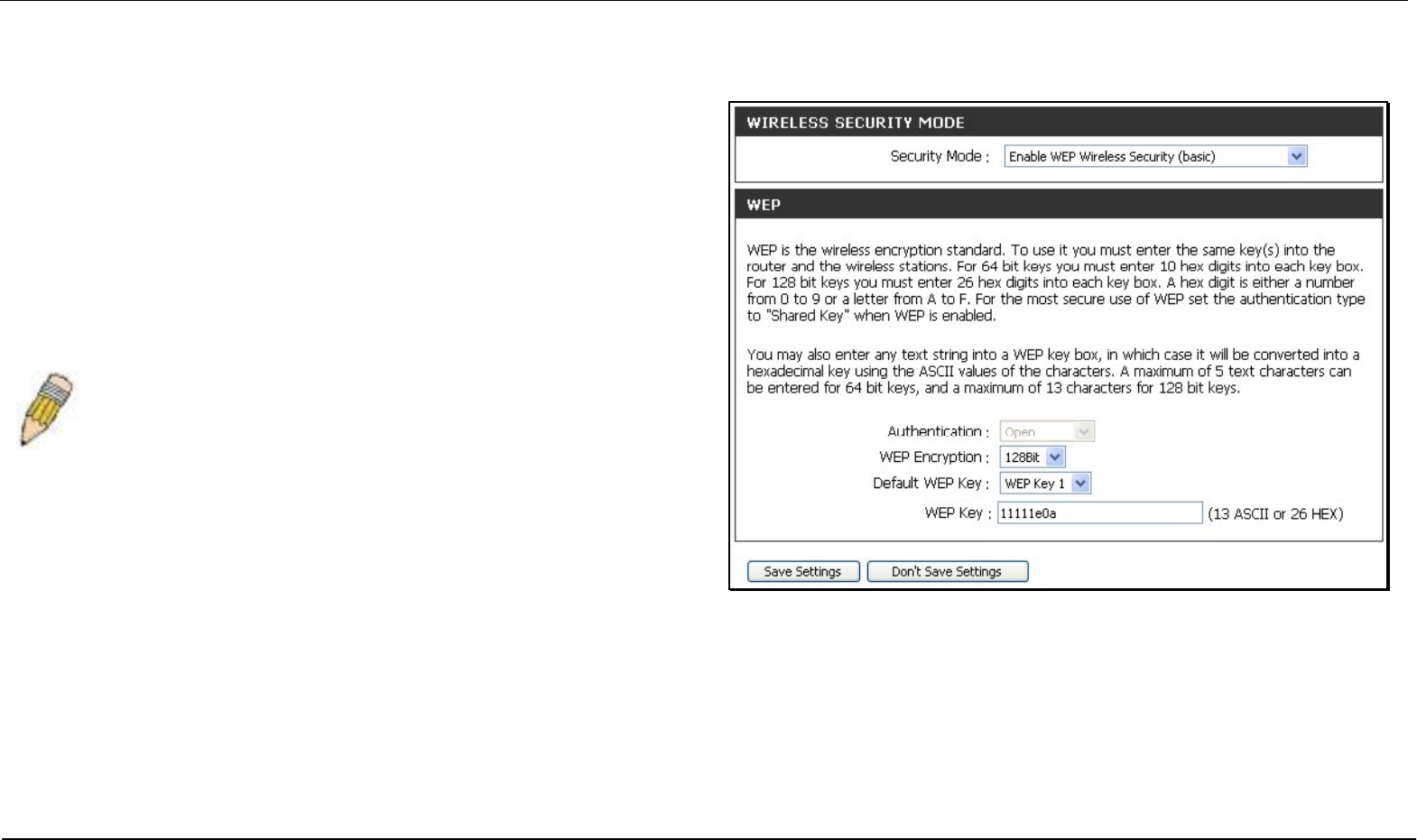
Section 3 – Configuration
D-Link DIR-320 User Manual 36
Wireless Security - WEP
WEP security requires the following parameters be defined:
• Authentication: Select Open Key or Shared Key.
• Encryption: Select the encryption level, 64-bit or 128-bit.
• Default WEP Key: Up to four keys can be configured. Choose the
key being configured.
• WEP Key: Type an ASCII or Hex key of appropriate length for the
encryption level, 10 characters for 64-bit Hex or 26 characters for
128-bit Hex.
Click the Save Settings button to save any changes to the wireless
network security settings.
NOTE: If encryption of any kind, at any level is applied to the router, all wireless devices using
the router on the network must comply with all security measures.
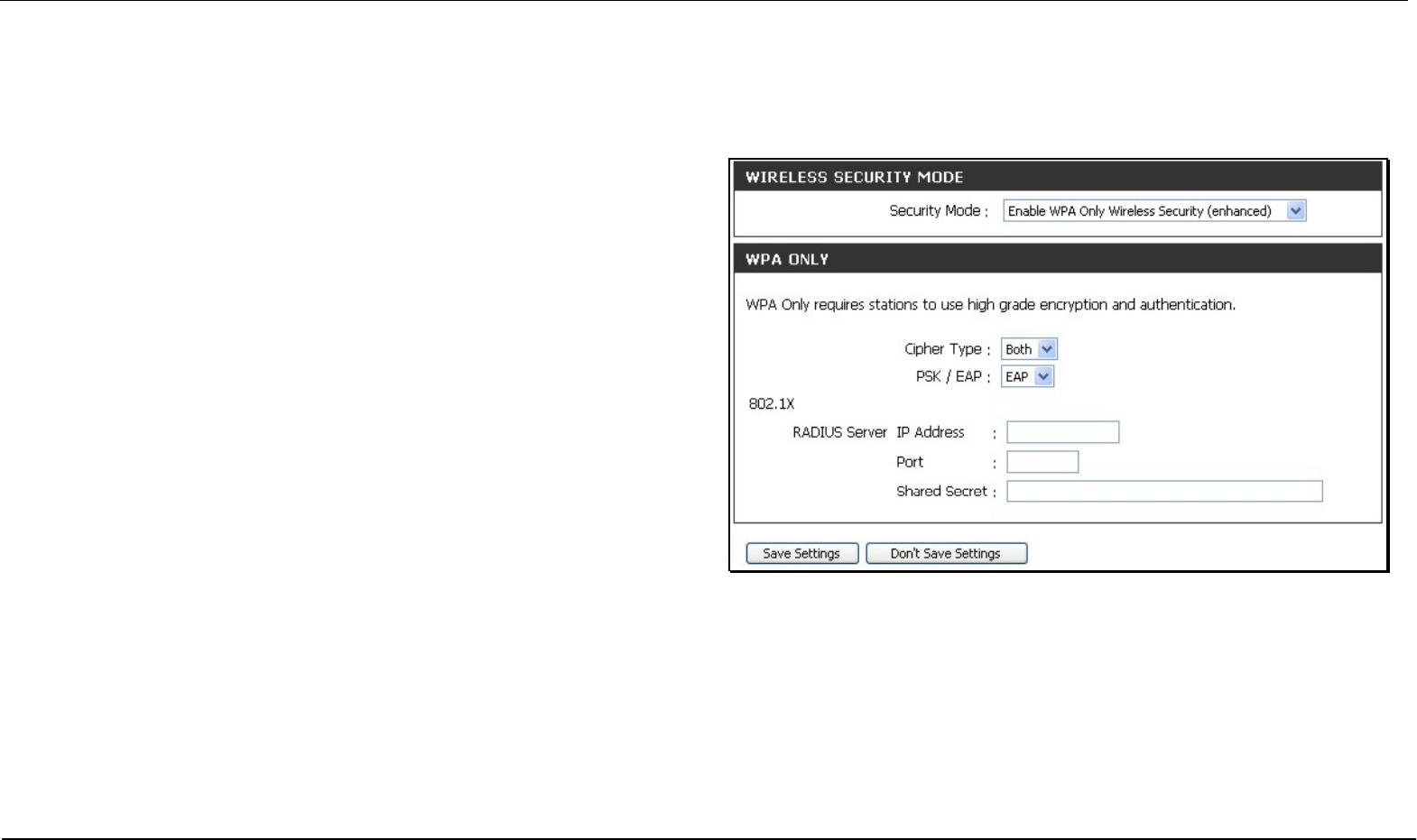
Section 3 – Configuration
D-Link DIR-320 User Manual 37
Wireless Security – WPA/EAP
Wi-Fi Protected Access was designed to provide improved data encryption, perceived as weak in WEP, and to provide user authentication, largely
nonexistent in WEP.
Enter the appropriate parameters for the type of security selected from
this menu. WPA EAP or WPA2 EAP must enter the following:
• Cypher Type: Choose TKIP, AES or Both.
• PSK/EAP: Choose EAP.
• RADIUS Server IP Address: The IP address of the RADIUS
server.
• Port: The port number used for 802.1x.
• Shared Secret: The password or character string used for wireless
station authentication.
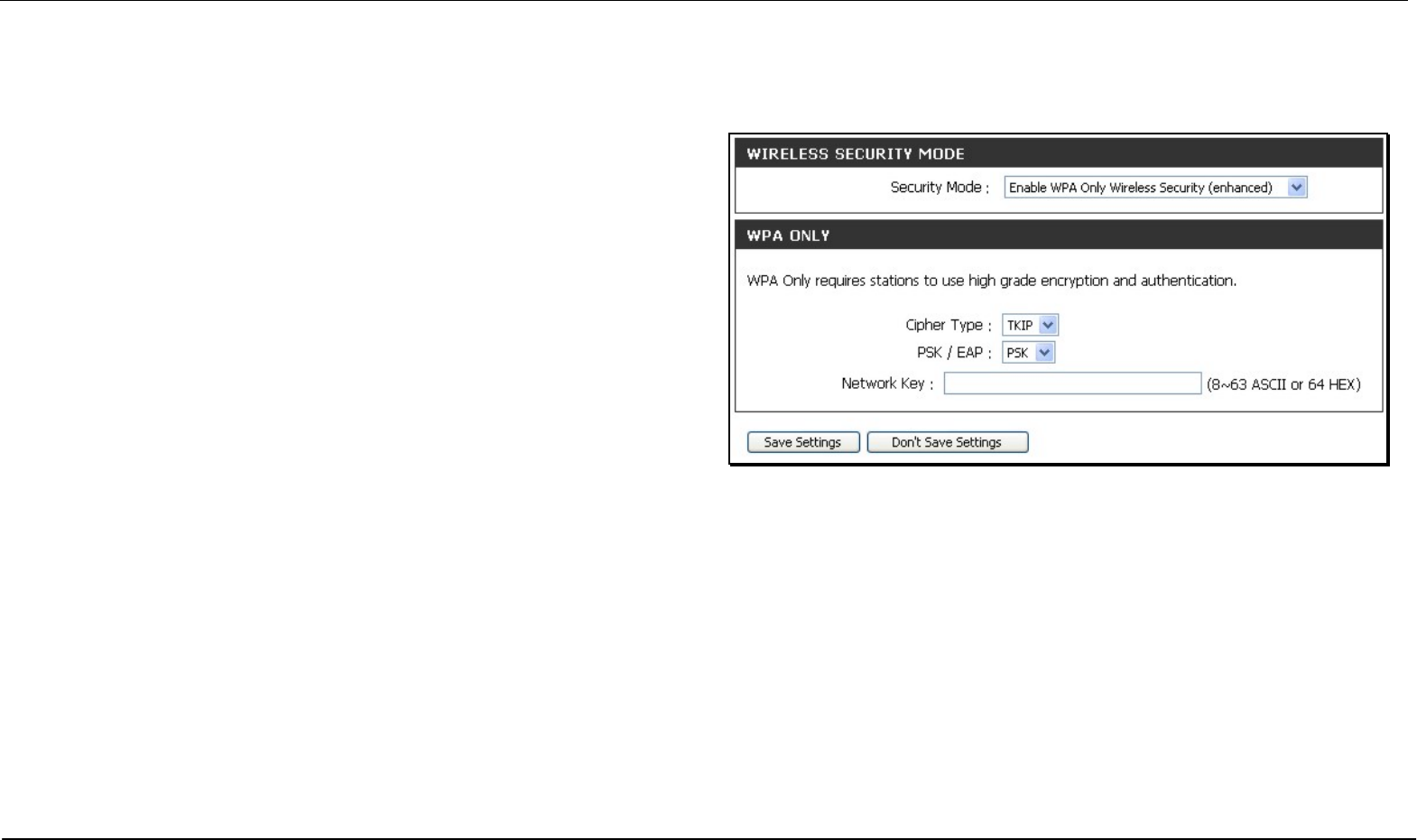
Section 3 – Configuration
D-Link DIR-320 User Manual 38
Wireless Security – WPA/PSK
Enter the appropriate parameters for the type of security from this menu.
WPA-PSK or WPA2-PSK must enter the following:
• Cypher Type: Choose TKIP, AES or Both.
• PSK/EAP: Choose PSK.
• Network Key: The password or character string used for wireless
station authentication (10 characters for 64-bit Hex).